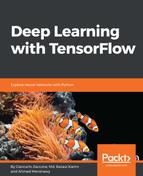In this chapter, we discovered three TensorFlow-based libraries for deep learning research and development.
We gave an overview of Keras, which is designed for minimalism and modularity, allowing the user to quickly define deep learning models.
Using Keras, we have learned how to develop a simple single layer LSTM model for the IMDB movie review sentiment classification problem.
Then, we briefly introduced Pretty Tensor; it allows the developer to wrap TensorFlow operations to chain any number of layers.
We implemented a convolutional model in the style of LeNet to quickly resolve the handwritten classification model.
The final library we looked at was TFLearn; it wraps a lot of TensorFlow APIs. In the example application, we learned to use TFLearn to estimate the survival chance of titanic passengers. To tackle this task, we built a deep neural network classifier.
The next chapter introduces reinforcement learning. We'll explore the basic principles and algorithms. We'll also look at some example applications, using TensorFlow and the OpenAI Gym framework, which is a powerful toolkit for developing and comparing reinforcement learning algorithms.
